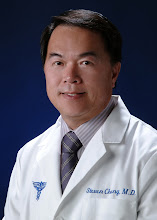Each patient is unique.
I offer individualized treatments to all my patients, especially the younger ones. Younger patients require particular attention because their hair loss progress is often unpredictable and donor hair limited. Under these conditions, hair transplant is not always the best option for young people. I have to use hair loss pattern, size, age, hair quality, gender and other factors to give them different plans.
These recommendations may include: surgery,
Propecia,
Rogaine, observation and sometimes a different hair style or hair color.
In the next several weeks, I will mention them one by one.
******************
Case 1a:A 32 year old male came for a hair transplant consultation.

His concern is his vertex area.
His vertex hair is thin and fine; the frontal hair is thinner and softer than donor hair. This is one of the first signs of hair loss.
Vertex thinning area is about 90 square centimeters.
Family History: His father is a
Norwood pattern class 6.
His main concern: He is young and has the potential to lose as much hair as his father did. If we do the surgery at the vertex now, we might run out of donor hair and be unable to cover the front in the future.
Treatment Suggested: No surgery right away, instead take
Propecia for six months. I always take pictures for comparison. Without the photos it is always difficult to tell the difference.
Case 1b:Some of my patients on
Propecia end up not having surgery after taking the medication.
This patient is on
Propecia and never had surgery.
Before Using
Propecia
After Using
Propecia
Case 1c:
23 years old patient came in for consultation. I advised him to take Propecia first.


The patient took Propecia for two years. The medication helped him grow hair on the crown area and prevented further hair loss.


There was still some thinning on the frontal area and receding hairline, so I
performed a hair transplant surgery and used 12 square centimeters of donor. The surgery increased density by 25%.
Conclusion:
He is very happy with the results. By taking Propecia first, he saved both a lot of donor hair for future use and the surgery fee.











































